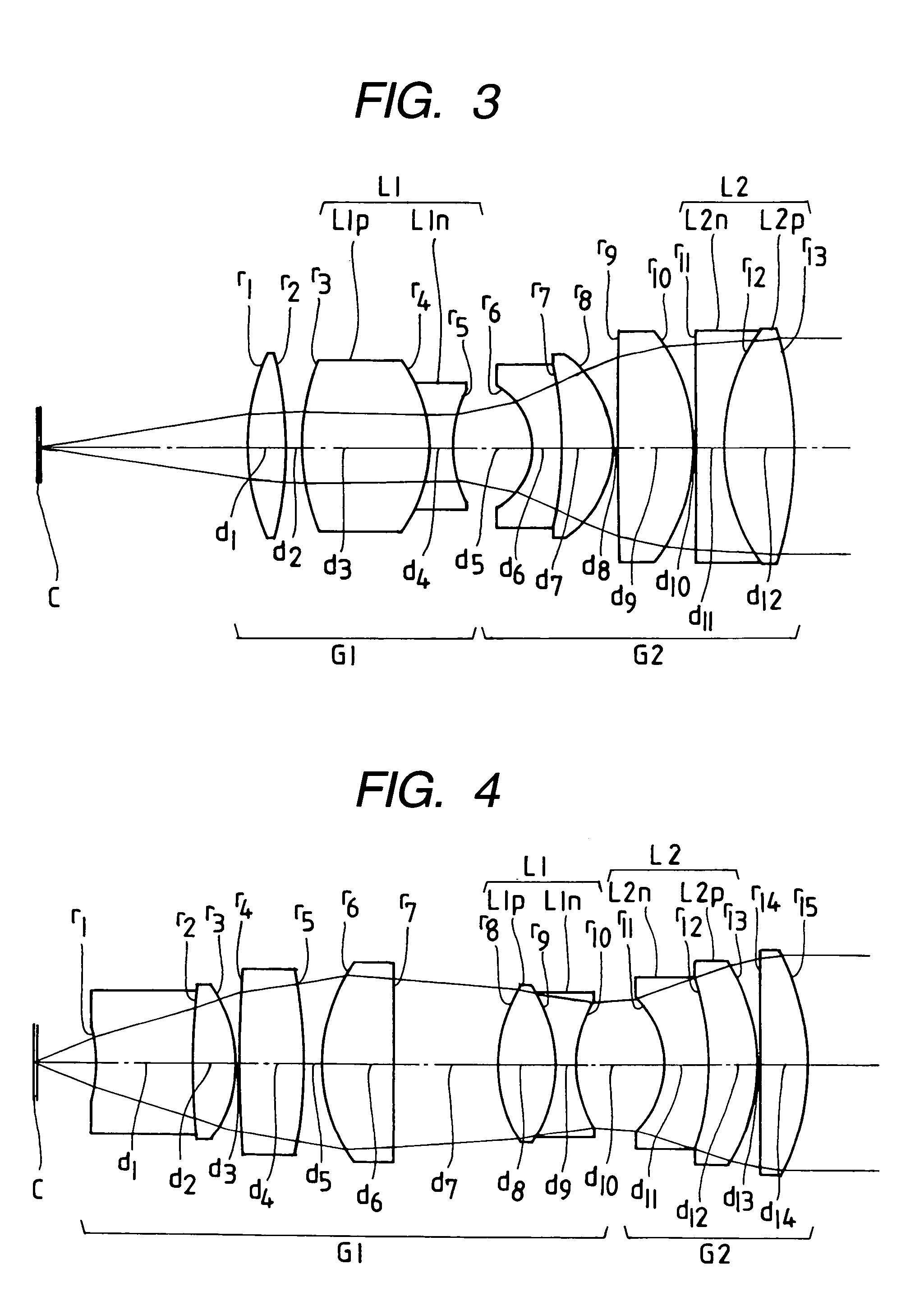Objective lens system for microscope
a technology of objective lens and microscope, which is applied in the field of microscope lenses, can solve the problems of unsuitability of objective lens systems, small numerical apertures, and long working distances, and achieve the effect of high resolution
- Summary
- Abstract
- Description
- Claims
- Application Information
AI Technical Summary
Benefits of technology
Problems solved by technology
Method used
Image
Examples
first embodiment
[0096]The first embodiment has numerical data listed below:
[0097]
f = 45, β = 4x, NA = 0.16, field number = 26.5,WD = 13.327r1 = 23.5100d1 = 3.3114n1 = 1.51633ν1 = 64.14r2 = −18.0816d2 = 1.1909r3 = 11.9099d3 = 8.3841n2 = 1.49700ν2 = 81.54r4 = −11.4327d4 = 1.4037n3 = 1.74100ν3 = 52.64r5 = 7.6802d5 = 4.9712r6 = −4.8583d6 = 1.8582n4 = 1.77250ν4 = 49.60r7 = 511.8307d7 = 3.2971n5 = 1.43875ν5 = 94.93r8 = −7.5362d8 = 0.2307r9 = −269.1995d9 = 4.7695n6 = 1.49700ν6 = 81.54r10 = −11.3589d10 = 0.3500r11 = −56.7065d11 = 1.2469n7 = 1.48749ν7 = 70.23r12 = 15.5159d12 = 4.2171n8 = 1.49700ν8 = 81.54r13 = −24.9502νd(L1p) = 81.54νd(L1n) = 52.64νd(L2p) = 81.54νd(L2n) = 70.23θCt(L2p) = 0.8258θCt(L2n) = 0.8924f(L2) = 79.799f = 45(1) νd(L1p) −νd(L1n) = 28.9(2) νd(L2p) = 81.54(3) {θCt(L2p) −θCt(L2n)} / {νd(L2p) −νd(L2n)} = −0.0059(4) f = 45(5) |f(L2) / f| = 1.77(6) νd(L1p) = 81.54
wherein the reference symbols r1, r2, . . . represent radii of curvature on surfaces of respective lens elements, the reference symbol...
second embodiment
[0099]An objective lens system has the first composition shown in FIG. 2. Speaking concretely, this objective lens system consists of a first lens unit G1 and a second lens unit G2. The first lens unit G1 consists, in order from the object side, of a positive lens element (r1 or r2), and a cemented lens component L1 (r3 to r5) which consists of a positive lens element Lp1 (r3 to r4) and a negative lens element L1n (r4 to r5) having a concave surface on the image side. Furthermore, the second lens unit G2 consists, in order from the object side, of a cemented lens component (r6 to r8) which consists of a negative lens element (r6 to r7) and a positive lens element (r7 to r8), a positive lens element (r9 to r10), and a cemented lens component L2 (r11 to r13) which consists of a negative lens element L2n (r11 to r12) having a concave surface on the object side and a positive lens element L2p (r12 to r13).
[0100]The second embodiment also uses a glass material which is excellent in tran...
third embodiment
[0103]A third embodiment provides an objective lens system for microscope which has the first composition shown in FIG. 3, and consists of a first lens unit G1 and a second lens unit G2.
[0104]In the third embodiment, the first lens unit G1 consists, consists, in order from the object side, of a positive lens element (r1 to r2), and a cemented lens component L1 (r3 to r5) which consists of a positive lens element L1p (r3 to r4) and a negative lens element L1n (r4 to r5) having a concave surface on the image side. Furthermore, The second lens unit consists, in order from the object side, of a cemented lens component (r6 to r8) which consist of a negative lens element (r6 to r7) and a positive lens element (r7 to r8), a positive lens element (r9 to r10), and a cemented lens component L2 (r11 to r13) which consists of a negative lens element L2n (r11 to r12) having a planar surface on the object side and a positive lens element L2p (r12 to r13).
[0105]The third embodiment has numerical d...
PUM
 Login to View More
Login to View More Abstract
Description
Claims
Application Information
 Login to View More
Login to View More - R&D
- Intellectual Property
- Life Sciences
- Materials
- Tech Scout
- Unparalleled Data Quality
- Higher Quality Content
- 60% Fewer Hallucinations
Browse by: Latest US Patents, China's latest patents, Technical Efficacy Thesaurus, Application Domain, Technology Topic, Popular Technical Reports.
© 2025 PatSnap. All rights reserved.Legal|Privacy policy|Modern Slavery Act Transparency Statement|Sitemap|About US| Contact US: help@patsnap.com



